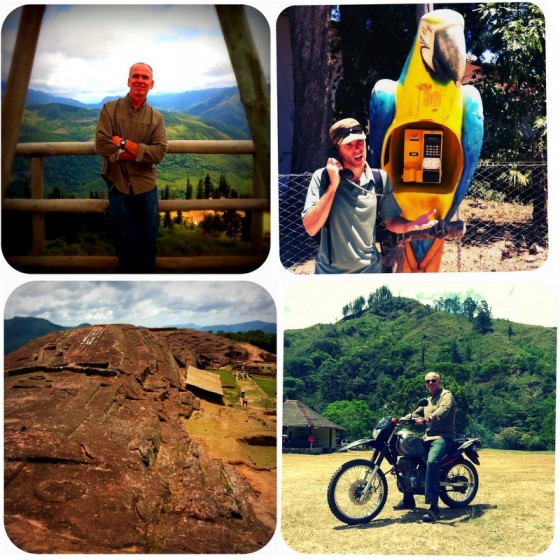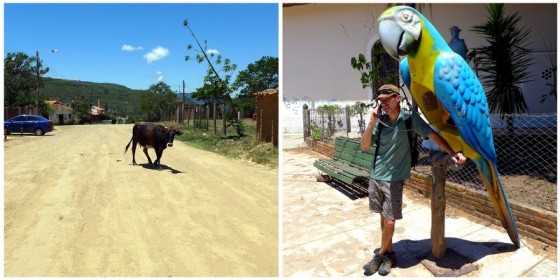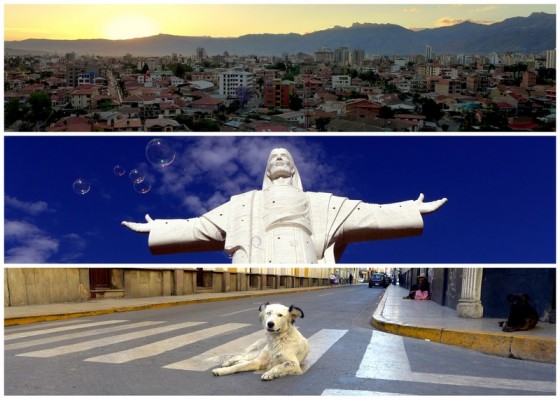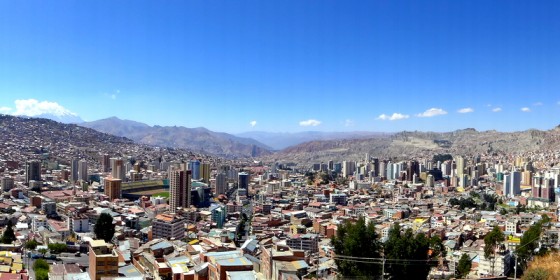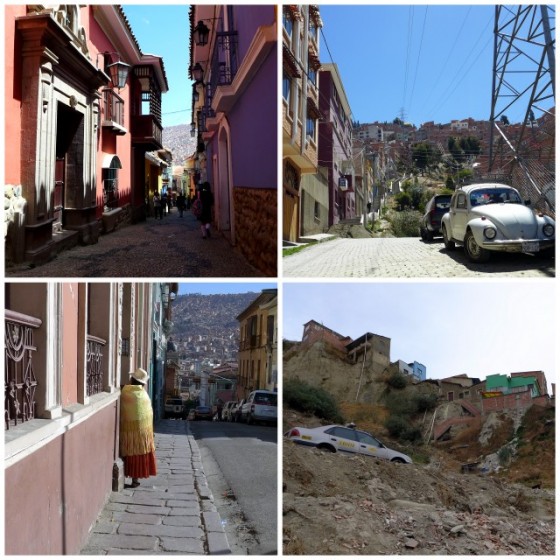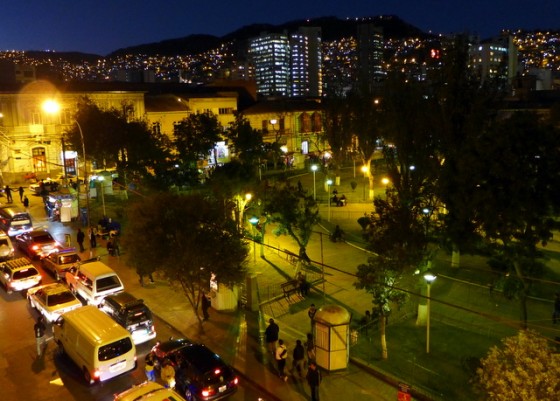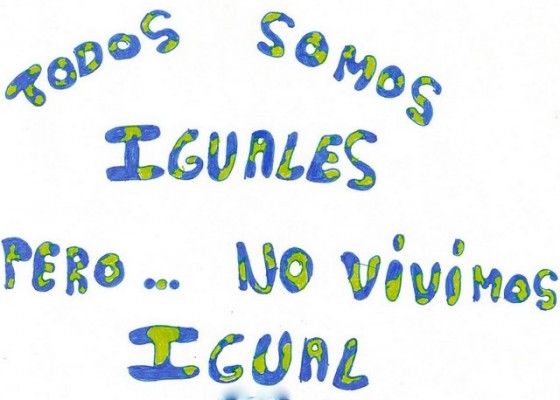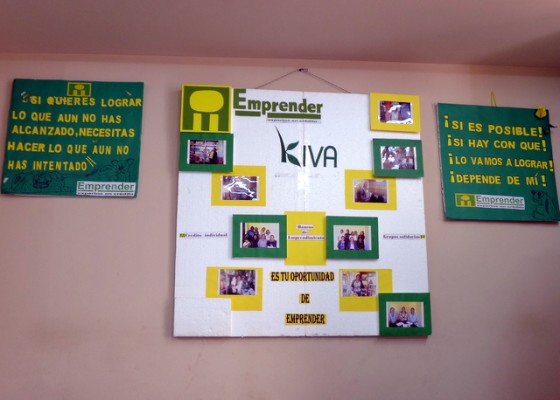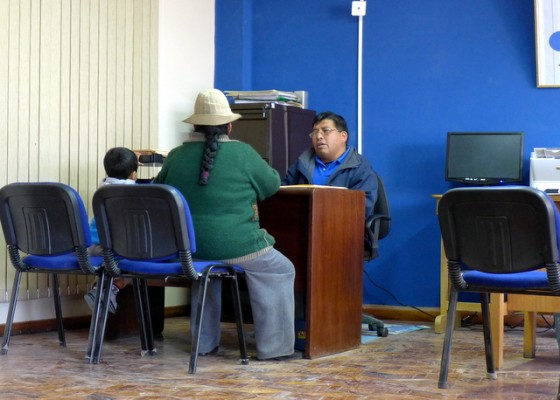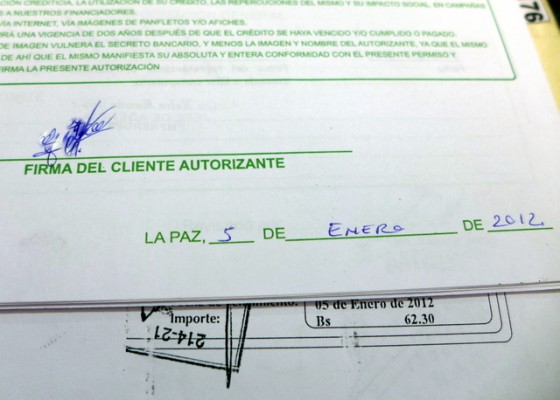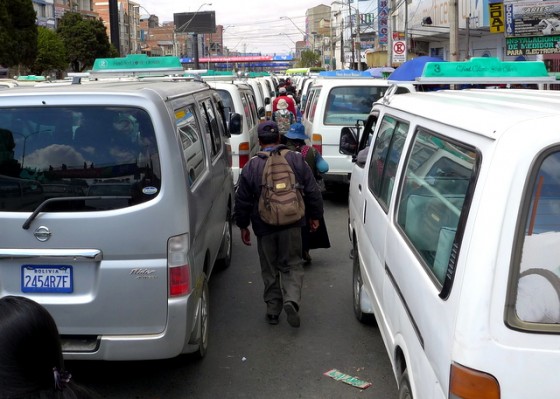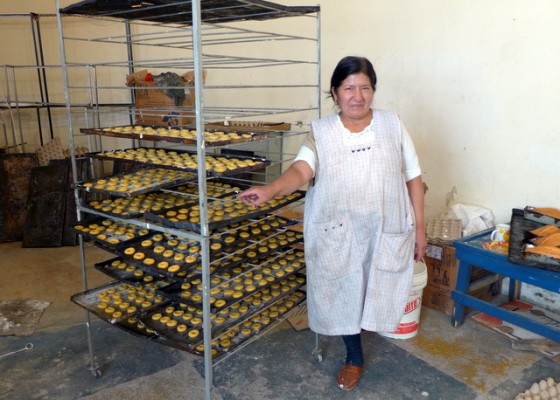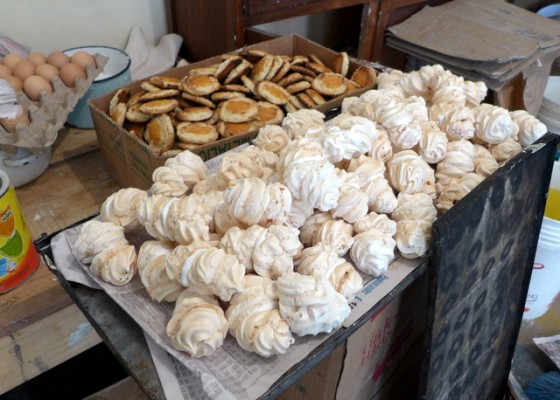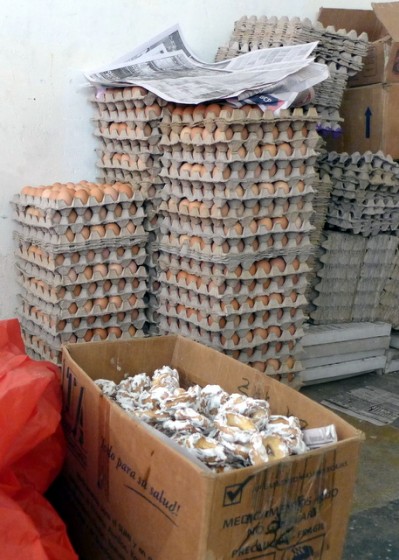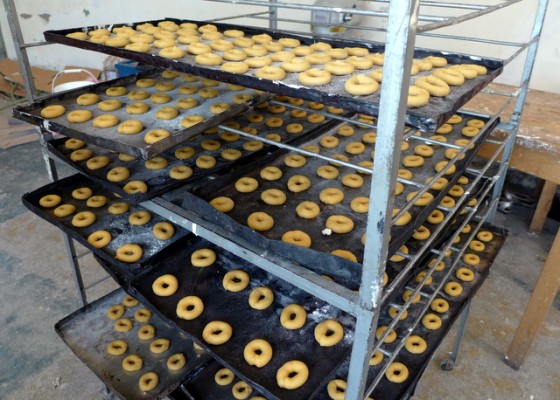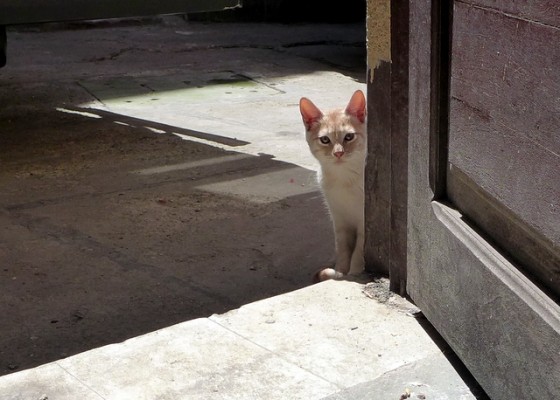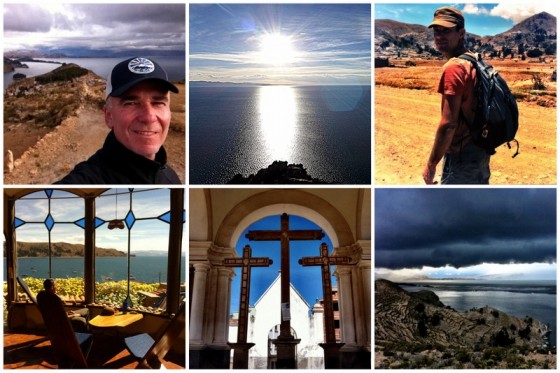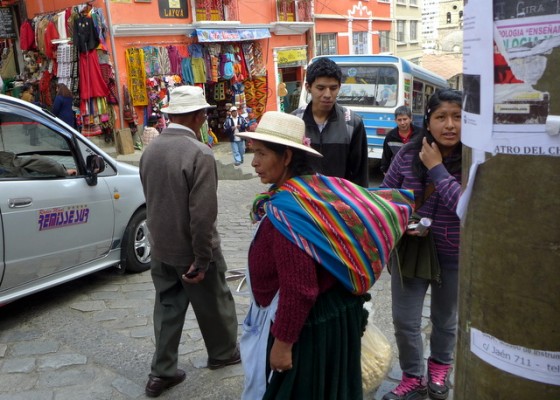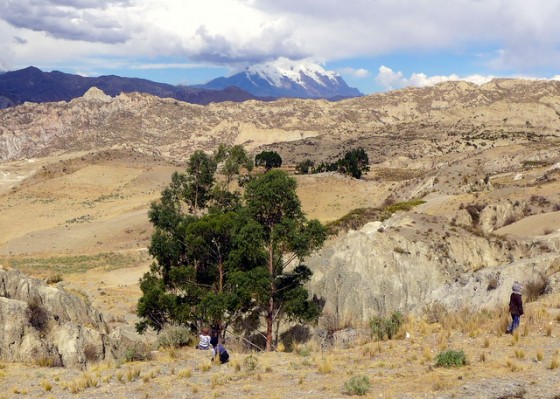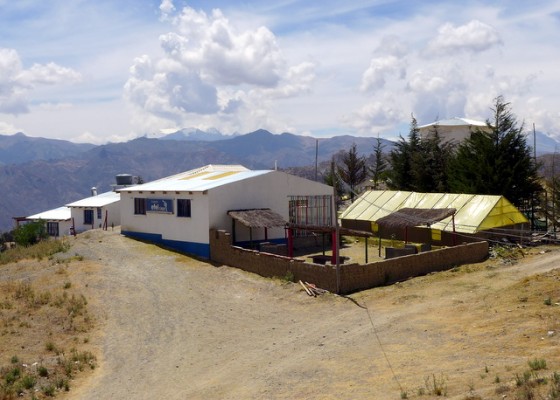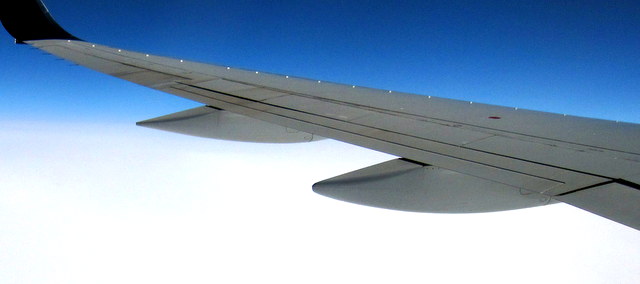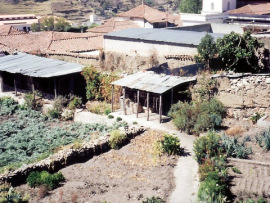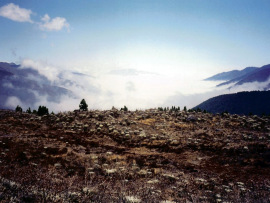This was a supreme six-week adventure through Andean lands, starting in Peru with my brother, Erik, and with a surprise visit from Paul in Cuzco. Then the second half I journeyed solo to Bolivia and northern Chile, finally looping back to Peru.
What follows are excerpts from emails sent to family and friends, my first trip where email was extensively used to keep in touch. Despite the crawlingly slow connection speeds and battered desktop keyboards, I managed to keep the loved ones informed through regular ether dispatches.
Arequipa/Cuzco
To: Paul
Date: 10/31/1999
Subject: SALUDOS DEL PERU!
Hey, Pablo, sweet stuff… it’s me, Pedro writing from Arequipa, Peru!
Erik and I are alive and well, in fact we’re having the time of our lives! It has been an incredible three days, and neither of us can believe we’re here in South America… we got here no problema on Thursday night and had a blast in Lima. We stayed in a beautiful neighborhood near the Pacific Ocean, and sat in an outdoor cafe drinking cerveza until 2 AM. What a blast! Lima was grand — we didn’t feel at all threatened, but kept our wits and actually enjoyed it. Then we took a bus to Pisco on the south coast where we met some congenial backpackers from Australia/New Zealand (my, they get around!) and spent the evening eating local catch seafood, drinking pisco sours, and enjoying seaside conversation. Very cool town coastal town — too bad we didn’t have more time there for the national park which offers great sea lion, penguin and various other wildlife sighting on the islands just off the coast.
Yesterday we went to the wine country, which is really the desert and instead of sipping sour wine, we headed deep into the sands to a natural oasis, whose lake has mineral therapeutic qualities. Soon we found ourselves hiking up the tallest dunes in the world with wax and sand boards, and proceeded to surf down surrounded by miles of stunning, barren desert with the grand Andes looming in the far distance. After many many falls on our boards, we washed the sand out of all our body orifices and sat back and relaxed over awesome seafood, (too) many beers, just reading/writing/siesta-ing. We needed the R&R cuz last night we took a 12 hour overnight bus ride to Arequipa, a beautiful colonial town in the foothills of the Andes (7000 ft). The bus ride was indeed “a trip” which involved mostly a hot, stuffy and bumpy ride over sometimes unpaved roads on the high cliffs over the Pacific. I mostly slept to the sounds of salsa, but Erik found the Lord Jesus Christ that night as he repeated novenas while peering through the dark and fog to the crashing sea far below, with the edge of the road just inches from the bus’ tires. Anyway, we survived and spent a glorious morning on the rooftop terrace of our awesome pension (old colonial with sunny patio — flowers everywhere!) peering at the imposing (and active) volcanoes surrounding Arequipa. They are beautiful, and marvelously snow-capped. I might come back here just to climb one and peer inside the smoky crater! The weather here is perfect — eternal spring! Today is the Day of the Dead in town, which (I was told) is a “quiet fiesta” but all day long we heard firecrackers, noisy processions, and large groups of festive folk shouting and having fun. It’s such a blast here!
As I write Erik is listening to live music at a local disco (but I think he’s also observing the chicas, whose beauty he constantly hails). I’m off to the cinema to watch a new Peruvian flick that a local recommended… I hope it’s good — if not it should be an experience. South American cinemas sell assigned seats and have escorts seat you (no, not that kind of escort).
The people are very friendly, and I’m finding them very easygoing and helpful. Not once have we felt at all threatened (but we’re keeping our wits) and are finding everything a delight (well, the bus ride last night was quite rank — ugh!). Tomorrow we’re off for a 10 hour DAYTIME ride (whew!) through the Andes to Lake Titicaca (13,000 ft) to visit some native tribes who live on floating islands (made out of reeds). Then the train to Cuzco, where we begin the Inca Trail. Erik is thinking about extending his trip by a few days or a week so we might go to the Amazon. That would be great! I like his company.
Anyway, so much more to say, but the bottom line is we’re happy and healthy, and indeed having the time of our lives! This trip is incredible, and I’m proud to say Erik has caught the travel bug. He says he’ll enlist in a Spanish crash course when he gets back.
I really miss you, Paul. I honestly do, very much. It was difficult beyond words leaving you at the bus station on Thursday. Erik has been great company, but I’ll really miss you once he’s gone and I’m traveling solo. I want to come to S. America with you — it’s awesome. We should DEFINITELY plan an Argentina/Patagonia trip in the next couple years! OK, amigo?
I’ll try and stay connected via email. There seem to be some internet cafes in the larger towns, so with luck we’ll connect every few days or so. I’ll also call you, sweetie, and I’ll shoot for Tuesday (11/2) evening (around 6-7 EST)… expect a collect call, since I couldn’t get your calling card to work in Dallas but I’ll try again here.
I wish you were here, bud. But I do know you’re with me, in my heart, and I can’t wait to tell you in person all about my trip through this awesome part of the world! In the meantime, I send you a GREAT BIG SOUTH AMERICAN (EMAIL) HUG! Bye, sweetie pie!
Besos, —Pedro.
To: Mom
Date: 11/02/1999
Subject: GREETINGS FROM PERU…?
Hi Mom. Did you get my first message? I haven’t received a reply, so I don’t know if you’re getting this. I have to run to take a shower before they turn off the hot water at 10 PM, so I’ll be quick. We spent the day cruising Lake Titicaca at 13,000+ feet visiting some FUNKY islands, and are still having a blast. Erik has a little altitude sickness, so he’s resting. I just finished dinner with some cool Germans. Got to run, but we’re off to Cuzco tomorrow but I’ll check messages on Thursday. If you are getting this, please respond so you know we’re OK. On Friday we start our Inca Trail trek so we’ll be out of touch until Tuesday morning.
I send my love, and I hope all is well.
Miss you, —Peter.
Sacred Valley
To: Mom
Date: 11/09/1999
Subject: Information I gave you over the phone…
Hey, Ma. Sorry for the quick phone message a little bit ago. I can’t believe Paul is actually flying down here as I type, what an incredible surprise! Here’s the information for him, I hope you can relay this to him before he departs Miami:
Arrive in Lima Airport. Go to Domestic Terminal and get on a morning flight to Cuzco. He can get money at ATM’s in the airport, also there are information booths that should speak English. IMPORTANT: he will be bombarded by people selling everything from hotels to taxis to tours — he should IGNORE THEM and don’t worry about being short with them.
He should first check for flights on AERO CONTINENTE from Lima to Cuzco. The morning flight times are: 5:45, 6:00, 6:30, 9:30, 10:30
If he can’t get on a flight, then check LAN PERU (AM flights): 5:40, 9:10, 10:45
Flight time to Cuzco is one hour. Get seats on right-hand side for best views of Andes.
Cost should be around US$80-100 and he can pay in US dollars or probably Visa. There are also ATM’s in the airport for getting cash. He doesn’t need to exchange to local currency at the airport since US dollars are accepted everywhere, but he might want to withdraw some for purchasing a telephone card to call me in Cuzco (a “20 soles” card will do). IT IS BETTER TO WAIT UNTIL CUZCO TO EXCHANGE MONEY.
I am staying in Cuzco at this hotel:
Name: Suecia II
Street: Tecseccocha 465
Telephone (084) 239-757. If he calls from Lima he needs to use the 084. From Cuzco, only the last 6 digits.
When he gets to Lima: first try and get a flight, then call me with the flight info and I’ll meet him at the Cuzco airport. If he can’t call me from Lima, then call me from Cuzco. If he can’t call me in either Lima or Cuzco, then in Cuzco get in a taxi and show them the hotel’s address and go there (I’ll be waiting). IMPORTANT: taxis are not metered, so he needs to negotiate a price before entering the taxi. The going rate to hotel from airport is about US$2, but they’ll probably try to get more from him — don’t pay more than US$3-5 (although I realize language may be a problem). Have Paul learn these numbers:
uno (one)
dos (two)
tres (three)
cuatro (four)
cinco (five)
Also “muchas gracias” is good to know!
Finally, if there is a change in plans and he can’t call me, then he should call you and leave a message. I will call you if I don’t hear from him by 11 AM CST (your time), also email me as soon as you have ANY information regarding our rendezvous.
I think that’s it. I AM SO EXCITED THAT HE IS COMING!!!! Boy, is he one lunatic boyfriend — I love it!!! We will have such a blast — first a trip of a lifetime with Erik (he loved it), now a tour with Paul — what a lucky guy I am!
Erik had a blast this trip, and left for Lima this morning. He flies to the US early Wednesday morning, and gets into MLPS around 1 PM CST.
I love you, mom. Please email me if anything changes and thanks for your help in communicating this!
—Peter
To: Mom
Date: 11/10/1999
Subject: PAUL GOT HERE!!!!!!!!!!!!!!!!!!!!!!!
Hey, ma! There was a handsome fellow here in Cuzco at my hotel this morning around 8 AM…. what happened to Paul??!! Kidding, of course, and he’s safe, sound, and tired, but we’re ready to have a blast.
Can you do us a BIG BIG (GRANDE) favor? Please call Paul’s mom and let her know her son is still in one piece. You know how mothers are… her office number is: 203-xxx-xxxx and her home number is: 203-xxx-xxxx. Try her at the office first, please, and just let her know he’s OK. Paul will call her when he gets back to the USA.
Anyway, that’s it for now. Erik should arrive around 1 pm CST. Please let me know (via email) that he arrived safely. I had such a great time with him!
I’ll write more in the next few days. I have so much to say about the Inca Trail hike!
Here’s Paul:
whew!!! 6000 miles just to get a piece of a%$. He better make it good!! Thahnks aagain for playing command post yesterday. <<it made the journey a piece of cake. <<this town is really awesome. <im sure <eric will give you the scoop. adios PABLO
Me again:
Paul really needs to get used to these South American Spanish keyboards, and since he ain’t gonna get no action down here, he’ll have plenty of time to learn to type south of the border.
Anyways, mom. Please tell everyone I’m still having a blast and will send more detail soon. Did dad ever send Kelly’s email address so I can send them directly to them?
Adios, te amo! —Pedro.
Inca Trail
Machu Picchu
To: Family/Friends
Date: 11/15/1999
Subject: INCA TRAIL TRAVELS
Hey, I finally had a LONG night’s rest and feel MUCH better. I have a nagging cough, but my energy is coming back — just in time since I leave tonight for Bolivia. Today I’m going to take it easy, do laundry, catch up on my journal, and perhaps see a movie. I’m also getting another poop analysis at a recommended laboratory just for a second opinion — it only costs about US$3 so it’s not a big deal, plus I’ll feel better if the diagnosis is confirmed. I find it difficult to accept that I actually have worms. YUCKO!
Anyway, enough of my travel tummy troubles and let me tell you all about the amazing Inca Trail and Machu Picchu. When Erik and I arrived in Cuzco we signed up for a tour after much debate as to whether we should do this on our own and rent the equipment (and carry it all, along with the food) or go on an organized tour that provides (and carries) the equipment and food. It was such a good call to go on the tour, even though it was more expensive (but still incredibly cheap at US$60 pp for four days). The Peruvian porters are amazing — they pack HUGE bags and crates on their backs and literally run up and down the mountains (in sandals)! Incredible stamina, and we all wonder how long they can last as porters. Sadly, some of the porters are mere adolescents (our reputable travel agency only hires adults), but all look older than they probably are. I’m not sure how well they are paid on the tours, but you can hire them independently for around US$6-7 per day, which is considered a decent wage considering the vast majority of Peruvians earn US$1 a day. Anyway, they were spirited and friendly, and along the way we offered them treats and water. We also gave a big tip, which they seemed to greatly appreciate.
The day before the trip Erik and I hiked up to the Sascuayhuaman (pronounced “sexy woman”) in the hills above Cuzco — an impressive Inca fortress/sanctuary with monumental stones fitted perfectly together without mortar (not even a knife can be inserted between the stones). Incan stonework is marvelous, even without considering they didn’t have metal tools or use the wheel. The Incas invented the wheel, but only used it on children’s pull toys — the reason it was never used for transportation or engineering was the simple fact there were no large animals that could be exploited for power. The llama was the largest animal in the southern hemisphere in pre-Columbian times and can only carry about 40 pounds (which can easily be saddled to the llama’s back). Consider a Europe without horses, mules and oxen — many of the architectural monuments of the Middle Ages would have been impossible. Anyway, I digress…
The hike up to the ruins was difficult given the thin air at 12,000+ feet, and Erik had a reaction to the altitude which worsened on the descent. Upon returning to Cuzco we headed straight to the tour agency and they were (fortunately) flexible enough to change Erik’s plans last minute. Instead of doing the complete 4-day hike, he decided to rest and relax in Cuzco for two days, then start an abbreviated 2-day hike and which met up with our group. Besides, the last two days of the Inca Trail are at a significantly lower altitude, and fortunately we were able to camp the last night together and enter Machu Picchu together — our objective! Before I left for the hike, Erik was still feeling the altitude but was better and encouraged me to still go on the 4-day hike and we’d meet up later. It was a bummer not hiking the complete trail with him, but he had a good/restful time in Cuzco on his own and we did meet up towards the end.
Going solo you never know what to expect on tours, but fortunately the other people on the trip were awesome — about 15 in total, nearly all were from English-speaking countries (England, Scotland, Australia, and New Zealand, and a single hardy American in addition to myself) with a few other scattered nationals (France, Holland, Brazil). All spoke English with the exception of the Brazilian, who was a great guy and we became fast friends (he spoke excellent Spanish). As with most people I meet traveling, he was quite interesting: he became a judge in Brazil when he was 26 years old (the third youngest in the country’s history), and now is completing an advanced law degree in Spain. He is married with three kids, and was in Lima for a Latin American legal conference and decided to do the Inca Trail before the sessions began. What a hardy walker! He arrived for the hike from sea level only the day before, and actually completed the 4-day trail in 3 days (he had to get back to Lima) with no altitude complications. He is an avid rambler and recently completed the Camino de Santiago, a medieval pilgrimage route from southern France, along the northern coast of Spain to Santiago de Compostela (St. James) in Galicia — an incredible 28-day journey! I told him about the Coast-to-Coast Walk in England which Paul and I just completed. He was amazing open-minded, always interesting, and a great conversationalist, so we spent long hours on the trail discussing our lives, countries, and experiences. This is why I love to travel — one constantly makes fast friends with the endless supply of fascinating people out there in the world.
The other people on the tour were equally interesting. New Zealanders who have circled the globe many times and Aussies (one a writer, one a government advocate for the aboriginal rights). There’s something about those from Down Under — island fever must be part of their culture because I see them everywhere. They certainly like to travel. There were two young teachers from Kenya on a 6-month sabbatical, two doctors from England (on leave as well), and a gregarious Scot who takes contractor assignments around the world (currently in Peru for a few months working for BellSouth which is aggressively entering the Latin American wireless market — smart from a business perspective since it is so much easier and cheaper to use satellite communications in countries where there is a poor or nonexistent cable telecommunications infrastructure).
There were many others from diverse backgrounds, but we all had certain things in common — a passion for deep travel, and the ability (or gumption) to take a leave of absence from work, etc. and hit the world. Most were traveling for a minimum of three months, which made my 6-week trip seem like a quick holiday, Erik’s 2-week a “weekend getaway”, and Paul’s 4-day trip positively insane. But we Americans have a different travel standard, probably because of our greatly limited vacation time. But clearly the were some other reasons behind these travelers’ trips, namely that few of the couples had children (most were younger and traveling before they had children) and most worked in technology and therefore had the means to travel for substantial periods of time. But from what I could tell, none were “trust fund” travelers — all seemed to work only as was necessary to allow for the next big trip. They were a lot of fun, and I greatly enjoyed their company for four days.
[LATER IN THE DAY…]
Hey, sorry I had to slip out but I had to get the results of the second fecal exam (how exciting!) and since I’m sure you are so interested in my intestines, you’ll be happy to hear that the lab found nothing wrong with my poopies! NO WORMS, WHOO WHOO!!! (No need to panic, Paul). They did a very thorough test (unlike the quick one yesterday) and found no bacteria or parasites, yippee! They said the diarrhea was caused by my cold, and said things should improve when I feel better. Yeah! I guess the constant precautions I take with regards to health and food pay off. I’m such a worry wort when it comes to health, especially down here when there are so many things passed through water, air, hands, etc.
What a marvelous afternoon here in Cuzco… there was a beautiful thunderstorm here which provided an appropriate backdrop to Camus’ “The Plague” (which I’m currently reading despite mother’s pleas to throw it away). After a wet couple hours, the dark clouds passed and the bright sun shone through — the air up here is wonderfully clear, and the views of the city and surrounding mountains were spectacular. I do love a good thunderstorm (I must be a Midwesterner).
Back to the Inca Trail… The hike was more difficult than I anticipated. The path itself was always solid and graded (the Incas were exceptional engineers), even when skirting high mountain cliffs. They even carved tunnels when necessary, some of which we walked through and are over 30 feet long. In the four days we cleared three major passes (14,000+ feet) which had me gasping for air with each step. But the views were marvelous beyond words, and the weather cooperated beautifully (it’s the start of the rainy season, but the real downpours hit in Feb-March) and had only momentary rain while we slept a couple of nights. The days were hot and the sun scalding (constant sunscreen at this altitude), but the night were VERY cold (especially when it rained). One night we camped at 13,500 feet and awoke with ice on the tent from the dew).
Certainly the Andes are a different beast than the tame White Mountains in my backyard. They are huge and endless, beyond the scope of any mountains I’ve comprehended before. And they are constantly changing: the terrain, the color, the contour, and the clouds. Every turn is a new perspective, and every clearing cloud reveals another sharp snowy peak. I’ve never been in such a large world as the Andes. And to think I’ve only seen the beginning — in Bolivia the peaks are higher, more numerous, with the rugged, bizarre altiplano stuck in the middle of the two major ranges.
Ascents and descents (of which there were many) provided a thorough look into the diversity of the Andes at close range. At the lower elevations there is almost rainforest growth with a vast assortment of flowers and bugs to boot. The rivers in the valleys roar after the rains, and the steep valley descents create incredible power as witnessed by the many waterfalls and smooth rounded granite boulders (pink, brown, grey, green — colorful stones!) in their course. These crashing, muddy rivers are hardly navigable, and it was plainly clear why the Incas built an incredible system of roads (over 20,000 miles — way more than Peru’s highways today) through the mountains instead of becoming master boat builders.
The highers elevations are thinly vegetated, but still host a wide range of wildlife, among them llamas, vicuna, condors (although no longer near Machu Picchu since the daily luxury tour helicopters have driven them away), puma, hummingbirds (over 130 varieties in Peru alone — I saw at least half a dozen different kinds). To be honest I was a bit disappointed with the animal wildlife because I expected to see herds of llamas and soaring condors overhead at all times, but they are lonely mountains. It could have been that my expectations were a bit off, but more likely the constant stream of hikers (hundreds a day in the high season) certainly takes a toll on the environment. In fact the most prevalent “natural” smell was human excrement, which led some in our group to refer to it as the “trek to Machu Peepoo”.
There are also many plants, most of which were used by the Incas (and still used today) for medicinal purposes. I befriended our guide, and since his English was limited, I got a much fuller description of the landscape and Incan culture. Within five minutes he pointed out at least a dozen plants used to cure anything from altitude sickness (three different remedies), sore throat, kidney ailments, herbs used for flavoring breads, you name it. Even today in Peru (generally speaking) there exists a close connection to the earth, which is apparent in their foods and natural remedies. Even yesterday when I was seeking heath at the regional hospital, it is very clear that modern medicine, religious mysticism, and natural remedies are all part of the cure. Erik and I visited a tribe on Lake Titicaca who still use almost exclusively natural remedies (but send tribes-people to town in severe cases where modern medicine is best) — they are also vegetarians, and have a strong sense of community and culture which no doubt helps keep them healthy. Although not all is so hunky dory health wise — the doctor at the hospital actually told me to drink lots of Coca-Cola (“for it’s mineral value”) to help rid the cold. Hey, I digress again — someone keep me on the Inca Trail, OK?
Well, I should get going so I don’t miss the bus to Copacabana — can’t wait to see Lola, you know, the show girl? (“Yellow feathers in her hair, and a dress cut down to there?”) I’ll continue this in the next few days, so please stay tuned. I also take requests, so if there’s anything you’re curious about just holler.
I’m thinking you always, and please rest assured (despite the intestinal talk) that I’m quite well, safe (Paul and Erik can confirm), and having a wonderful journey. More soon!
Love, —Pedro.
Lake Titicaca
To: Family/Friends
Date: 11/21/1999
Subject: CITY OF PEACE
Hello, amigos!
Another missive from South America, this time from bonny Bolivia! Well, yesterday I finally felt myself again after what seemed like an eternity of malaise and assorted intestinal “issues”. After a convalescence in Copacabana, a sleepy border town on the Bolivian side of Lake Titicaca, I healed with a fellow Inca Trail traveler, a Scot named Scott, who I happened to bump into on the border. Together we trekked the Island of the Sun, the mythical origin of Tiahuanku and (later) Incan civilization — an incredible creation story involving condors, pumas, green jewels, woman, man, and exile. There were various celebrations in Copacabana, which involved all-night revelry (I was too ill to participate) and many a procession which included marching bands reminiscent of Cajun funeral dirges and 1970’s muscle cars decorated bumper to bumper with flowers, shiny table settings, kitchen appliances, and Barbie dolls (fascinating!). I never did quite figure it out.
Not yet ready for the Big City (La Paz), I then jumped to Sorata (or rather jangled my tired body over unpaved roads up to the altiplano and down the rugged Andes) to find peace in the wonderful Residencial Sortata, a turn-of-the-century manor home turned backpacker haven. I sat for a day and a half in the garden containing a thick assortment of blooming flowers, sweet fragrances, Quechua-speaking parrots, and marvelous food served up at the residence. I had a great room overlooking the largest geranium garden ever (they were are tall as me!), with the snow-capped peaks all around in the distance. The sunsets were incredible — amazingly, in the deep Andes the sunsets are richly black and white, perhaps more stunning than the Kodachrome variety (well, I take that back — every sunset is spectacular).
Yesterday I bussed it to La Paz, tumbling through gravel and dust, hill and dale (“hair-raising cliff and precarious precipice” is the Andean translation). It was a painful five-hour ride, during which I desperately needed to go #1 practically the whole time and I was too fearful to go because 1) there was nowhere to do it (without having the entire bus as spectators), and 2) the driver, I was convinced, would never have waited for me to seek out a urinal in the one-horse towns we briefly stopped in (“slowed” is more like it). As a side note, there I counted two (count them: TWO) times that the locals somehow managed to pee in a plastic bag, hand it to the person seated beside them, and casually toss the sample out the window. I was amazed by this curious habit, and more than slightly interested in its feasibility for a gringo badly needing relief. The first local exhibiting this special ability was a male, which I contemplated for a moment and decided was possible, but the second person was a female — egads! The local Indian women wear marvelously colorful petticoats and (the Scot informed me) “go kilt style” (read: no underwear) which only partly explains it. Anyway, the landscape on the altiplano is stark and bizarre, well worth enjoying, but I was too engrossed in planning the “bag method” to really pay attention. Well to finish this story (which I’m sure you’re all ready for), I opted for pain and (besides I didn’t have a bag and the bus was full — hardly the place to experiment). I arrived in La Paz barely able to walk, and practically dove into the first public restroom.
Anyway, La Paz was a delightful surprise! The climate is superb — warm, dry, air crystal clear (at over 13,000 ft) and the congestion is minimal (partly due to the lack of easily navigable roads, and the gentle breeze through the valley which takes the pollution to places far from me). I found a great little hotel — perfect for me: cheap and organized. I wandered around the city, enthralled by the bizarre local markets on seemingly every corner, selling everything imaginable and them some (the dried llama fetuses were a bit much). After a hearty dinner at some macrobiotic, natural healing, holistic spa I headed to the theater where I joined the Bolivian intelligentsia to see a new Bolivo-Peruvian drama group present an early 19th century German romantic social drama involving murder, class issues, and puppets. It was strange. Not only the lofty German romantic prose translated to Spanish posed a bit of a challenge, but the real kick was the (heretofore unknown) fact that the playwright died an untimely death at the age of 24 and thus was unable to finish the play. So after a couple hours of woeful eyes, cryptic dialogue, and much stabbing and sobbing, the actors just walked off the stage to conclude the piece — no resolution, no “come together” ending. Oh, the puppet part was half a horse (the rear half) that kept appearing at odd moments to fart or poop, oblivious to the characters. The Bolivians seemed to get much more out of it than me, and when it “stopped” I politely applauded and made straight for the door to enjoy a walk back to the hotel, pondering nothing but the crisp air, the bright stars and moon above, and the twinkling lights of La Paz surrounding me in the valley. It was a perfect night, and despite the play’s shortcomings, it was still better than “Cats.”
This morning I attended mass at the San Francisco church, considered a colonial architectural marvel despite its inability to stay up during La Paz’s frequent earthquakes. It is a beautiful building, and I enjoyed a moment of quiet contemplation. Upon leaving the service I encountered a bunch of unlikely (for South America) gatherings in the plaza outside the church: a sexual health fair which included booths advocating gay rights, women’s reproductive rights, contraceptive methods training (complete with several interactive dildos), and indigenous sexual health issues. Also in the plaza was a group commemorating the 30th anniversary of the Interamerican Human Rights Treaty signed in Costa Rica the year of my birth. I couldn’t help but recall the largely appalling and tragic human rights record in Latin America over the recent decades, but found some consolation in the dedication of the group to continue to work for these rights we take for granted but are still not achieved in many parts of the world. Furthermore, there was also a group (albeit small) advocating good treatment of dogs, which are mostly ignored and in many cases abused down here. Sad, really. But I found large amounts of energy in La Paz, with these groups and in the upcoming municipal elections — there are 15 candidates and today they were all out in force on all street corners and plazas campaigning hard. It is a motivated, hopeful city and the populace is very welcoming. Of the Latin American capital cities I’ve seen, this is by far one of the more livable and enjoyable. Had I more time, I could easily spend more time here but I’ve got to keep moving — so many wonderful things to see!
I made an interesting visit to a Bolivian jail here in La Paz, which was not exactly heartwarming. It was totally surreal — it operates completely like a city within a city, where there are various sectors (some more “upscale” and safer than others) where the inmates have to rent or buy cells. Inmates gamble, set up businesses, and you can buy anything in there (in fact some travelers to Bolivia actually go there to buy cocaine!) — money is everything. The government only provides two meals a day which are reputed to be tranquilizer-laced so many inmates don’t eat them. The gov doesn’t provide cells, medical care, legal counsel — inmates have to pay for all of these. No money, no services — they depend completely on their own businesses or outside funds (i.e. family, friends) for sustenance. My tour guide (an inmate, and very candid) charged US$6 for the tour, which he puts to his nest egg — when he gets $25,000 (“for the judge”) he’s home free. Everyone tries to make a buck. There were markets everywhere — rotisserie chicken shops, photo developers, bakery stands, liquor stores, electronics (including TV’s, stereos, electric razors), you name it. Cells are bought and sold like real estate (my guide bought his for $1,500 and will sell it when he can for $3,000). And there was no guard presence; they never enter the prison but solely maintain the entrance, where they supplement their incomes with contraband to the prisoners. The prisoners are organized to “maintain the peace” as best they can, but needless to say there is violence but never during visiting hours since they depend so much on outsiders (and their code is very protective of women and children, who were everywhere in sight during visiting hours). It was an incredible experience, most memorable ever — and more than slightly disturbing.
Anyway, please note that I am not incarcerated there (or plan to be) and will freely make my way south to Potosi tonight. I’m not sure of the email situation outside of La Paz (it was not good in Copacabana or Sorata), so there may be a lull. But I will stay in touch via other means…
Thinking of you all, con carino, —Pedro.
Potosí
To: Family/Friends
Date: 11/23/1999
Subject: DEEP WITHIN THE MINES
Hey, just a quick note to let you know I’m healthy and happy. Had a great couple days in Potosi (not Illinois) touring the silver mines and visiting the most amazing Spanish colonial building I’ve ever seen: the National Mint used by Spain during the colonial period to create vast amounts of wealth at the horrible expense of millions of indigenous and African slave lives.
Why does it seem that most of the amazing buildings in the world have to do with money? There are churches, of course, but down here they have to do with money as well. Most of the religious iconography in Potosi (I’ve visited many churches here) deals with justifying the horrendous systems of slavery and encomienda (forced indigenous labor) required to amass great wealth for the Spanish Crown, and by extension, God.
I must admit these past days have been emotionally overwhelming for me to witness first hand the Latin American socioeconomic history I studied in college and beyond, and believe me it’s not a smiley-face story.
Yet the tragedy continues to this day, where this morning I saw many of the thousands of miners who still work the mines in medieval conditions (the techniques — and safety — have not changed in centuries). I stand at the end of the 20th century, a period of spectacular progress, yet these Bolivians who work the mines of Cerro Rico live barely ten years past my thirty.
But I am amazed at my constant discovery of the many wonderful aspects of Latin America, which allows these people persevere and be beautiful.
Well, nuff said for now, and I hope to get another (longer) message mailed before I get lost on the lunar salt seas of southern Bolivia over the weekend when I won’t be in contact.
Thinking of youse guys, indeed. —Pedro.
To: Paul
Date: 11/23/1999
Subject: DIRTY UNDERWEAR
Hey, sweet stuff. It’s a good thing you’re not here now cause I’m beyond dirty underwear — I’ve completely given it up. Today I spent my last pair crawling through the dusty, muddy mines of Posoti. An incredible experience, but now all my laundry is at the cleaners and all I’m wearing are some ridiculous rags (commando style).
Anyway, sweets, I’m sorry to hear you still have the madre of all colds. Ugh. This afternoon I met up again with a South African chick Erik and I met in Arequipa, Peru the first week of our journey and she currently has the Peruvian cold from hell — she’s been nursing it for nearly two weeks (and so worn out by it) but fortunately mine only lasted a week — I hope it’s winding down for you by now… oh, sweet stuff, you’re down to getting takeout pizza. If I were there I’d make you a nice faux chicken soup, a hearty bean stew, or perhaps my specialty: insta-Indian from Trader Joe’s. Seriously, bud, please get better soon cause I’m starting to feel REALLY guilty about this.
Hey, I just finished reading the James Herriot book and I am ready to move to England and become a vet. We must start planning our shift there — I don’t care when we go (although sooner would be preferable), just let’s start figuring out the details and plan-o-rama, okay sweetie? I had lunch yesterday with three Brits who have rented a 4-wheel drive for 8 weeks and are driving south through Argentina to celebrate the new millennium in Tierra del Fuego then drive back up through Chile. They saw I was reading the Herriot book and the conversation took off from there. One had done the Coast-to-Coast three years ago (didn’t finish, though). They got me especially riled to move there, so you’re gonna hear a lot about this when I get back so be forewarned.
Hey, Paul, I better go start another email to the group about my experiences of the past few days — they’ve been grand. Tomorrow I bus it to Uyuni where I will tour the salares then cross into Chile. I’m having dinner with two nice Germans (yes, you read that correctly) who are geologists living in Chile and will give me the scoop on renting a 4WD vehicle (I could use your Pathfinder down here) and getting off the gringo trail and hitting the spectacular Andes hard — they’ve done it and could only rave about it. But I’ll need to meet up with others to split the cost and for safety (it’s pretty desolate and cold at those heights so better to be with at least one other). A solo Brit from our mine tour today will probably join us for dinner, and I’m so starved (this was a cracker/banana day) and can’t wait to start chowing (it’s a veggie restaurant — no cheese sandwiches, yippee!).
I’ll try and call you tomorrow night between 7 and 8 pm EST, okay? This, of course, depends on when I get into Uyuni (which could be real late) and I won’t try if it’s past your bedtime (I know you have to get up early to fly, boo hoo). I’ll try and quickly check email tomorrow AM before I leave, so please let me know if this time doesn’t work or your flying schedule changes.
I miss you, Pablo, and want you down here where I can take care of my sweet sickie. The days are winding down on my journey, and before long I’ll be back to whoop yo ass back in Portsmouth!
Adios, y te besare a pesar de que tengas la gripe, okay? —Pedro.
Salar de Uyuni
San Pedro de Atacama
Parque Nacional Lauca
To: Family/Friends
Date: 12/01/1999
Subject: BOLIVIAN BREAKDOWNS
Hola, everyone:
After a long time from email (southern Bolivia is really off the beaten track), I’ve finally made it to Chile, where I am spending a few relaxing days on the beach as I make my way north towards Peru again, as I need to get back to Lima in a week for the return trip. I can’t believe it’s nearing the end — my, how the time has flown.
Before crossing to Chile, I had the grand fortune of spending three days in the high altiplano among unbelievable landscape and among good people. Before I go into the details, I want to start with the bad: the guidebook warned that tours from Uyuni in Bolivia (a nowheresville in the high southern desert — water from 7 until 9 pm, and electricity only sporadically) are anything but problem free, and indeed everything that could have gone wrong with the tour did:
The cook for the three days didn’t show up and could not be found, the agency forgot to pack water (which was promised us so none of brought our own), and about three dozen eggs were smashed in the trunk on the first day, which aside from the smell for the duration on the trip, was particularly vexing to us vegetarians who were “looking forward” to omelets each morning, noon, and evening for three days. On the second day the cap on the spare gas container on top of the vehicle came loose and dumped about three gallons on the windshield and through the open window on the driver’s side — at least the fumes overwhelmed the eggs, which was preferable.
The 4WD vehicle was another source of constant problems: it never failed to have trouble starting (we had to park it strategically uphill so we could push it downwards to start again), the tire kept going flat (like 2-3 times per day), the water froze each night (it got to -20 F at that altitude) and took a frustrating hour to get it going, and the rear suspension broke on the final day. The worst was the tape deck — there was one cassette that could not be removed or stopped (since the “off” mechanism was the absence of a cassette), so we heard the same music for three days — a hoaky Bolivian version of country-western. An added bother was that each night my dreams were accompanied by those songs.
Moreover, due to delays because of car problems, we consistently got in late to the camping areas and got the dregs of accommodation. Also, one German got seriously ill from sunstroke and had to evacuate him (but the CB was broken so had to drive him several hours out of our way — BTW he’s now fine). Oh, there were other things but I won’t bore you with the details.
Fortunately the group I was traveling with was awesome. Five young Israelis, three Germans (“all smiles and sunshine” as Erik would say), and a slightly insane Swiss woman, who I ended up traveling with for a couple of days afterwards — she was a lot of fun. We bonded immediately and decided English was the one common language but only rarely was it used. It was strange indeed to be surrounded by not-my-native tongues for three days, but I guess that’s how a good part of the world feels when traveling. I did manage to pick up a fair bit of German and Hebrew, and uncannily I started to think I understood their non-English conversations and found myself agreeing with them and nodding my head with a “yah yah” from time to time even though I had no idea what they were saying.
But the whole trip was really loads of fun, and the challenges only added spice. The first day we traveled the Salar de Uyuni, the largest dry salt lake in the world (some 12,000 sq km), which was totally bizarre. It was the whitest white for as far as the eye could see towards the sharp Andes ranges off in the distance, and as flat as the ocean. It was bizarre — seemed like snow, but it was hot and gravelly. We toured a hotel made entirely of salt blocks (furniture and all), lunched at one of many islands — soaring peaks shooting straight from the flat salt bed.
From there we headed to many other spectacles, including blasting geysers, hot and murky, spewing varied colors of mud in all directions (a greenish slime landed on my right glasses lens — not at all laughable in an area devoid of water to clean it with). They were loud like a thousand boiling teapots, and reeked of sulpher. The Israelis thought it appropriate to turn on their portable stereo so we all danced to the Gypsy Kings for a couple songs amidst the awesome geysers. Sounds corny, but it was great — I guess you had to be there.
We drove past countless fields of vicuna, llamas, and alpaca — three of the four serene camelids that dwell in the area, and played with the vizcacha (cross between squirrels and rabbits) who like to hang out among the rock outcropping and spit at tourists. Saw condors, and many many pink flamingos on the many salt lakes in the area. And when we weren’t watching the fauna, there were the occasional petrified rock “trees” of huge lava boulders rested improbably in the sand — imagine an elephant balancing on his trunk. Very Dali-esque.
The lakes were spectacular — all sorts of colors: some green, some blood red, some sky blue with the dried salt perimeters, and even one that changes color during the day (from blue, to aquamarine, to bright green) as the temperature changes and wind during the day agitates the bacteria in the waters.
Surrounding these natural wonders was the omnipresent snow-capped Andes and the stunning cobalt blue sky. Most of the land was 15,000 ft desert, a quiet and stark terrain, that mostly seemed colorless at first glance but demonstrated a remarkable changing pallor. For example, the Peak of Seven Colors was really a dry, desert peak but contained a beautiful array of seven earth tones that changed as light shifted across it. The land was beautiful beyond comprehension.
After three days we crossed to Chile, where I instantly felt the effects of a much more developed world: newer, bigger vehicles, straight paved highways, efficient border control, and totally reliable restaurants. I rested in San Pedro near the border for a day with the crazy Swiss woman, and biked to see the sun set at the nearby Valley of the Moon, a crater-like canyon complete with massive dunes to climb over and run down. I thought it would be an easy 10-mile ride, but I did not factor in biking uphill (nearly 300 ft), directly into the sun and wind, and on an unpaved, sandy road. It about killed me, and I thought on several occasions to give up and turn back but I perseverance won over and I arrived to see a spectacular copper sun descending slowly at my feet. The trip back to town was simple and satisfying (since all the factors mentioned above were now working with me, not against). I rode towards San Pedro tucked at the foot of a majestic 19,000 ft volcano with the sky above me ablaze in violet and orange and blue, happy as a clam. I thought “I’m in South America, biking through the Andes, with the fine setting sun” and couldn’t imagine being anywhere else at that moment. It’s one of those traveler’s high moments, of which I’ve had so many during the past few weeks. It’s been such an awesome trip!
Well, I’m off to a hearty Chilean sea bass and red wine dinner, and tomorrow I head to Arica to tour another national park. Friday I cross back to Peru to hike the Colca Canyon (deeper than our Grand Canyon) near Arequipa, so I’ll try to send another email this weekend.
I hope all is well with everyone, and please know I’m fine and healthy and happy. Hasta pronto!
Ciao, —Pedro
Arequipa/Nazca
To: Family/Friends
Date: 12/08/1999
Subject: IN THE AIR
Hey, todos —
A quick update, as I’m scheduled to fly home early tomorrow AM, and I’ve been riding on a bus 17 hours and overnight, so I need to get some sleep pronto. I can’t believe it’s about over… but let me back up a few steps and let you know what I’ve been up to.
I spent the last few days in Arequipa, Peru, a lovely spot to rest and relax. I had a couple nice days in its eternal spring climate, and had the great fortune of bumping into Pru(dence) and Nik, two gregarious Aussies with whom I hiked the Inca Trail nearly a month before. As luck would have it, I met them on the street the day before they were to return Down Under (via Easter Island — awesome!) so we spent our time hanging out and tipping a few (too many) Pisco Sours as a send off.
The next day I somehow got this harebrained idea to climb Mt. Chachani in the area, an inactive volcano that stands a tall 6,057 meters, or nearly 20,000 feet. Faced with the option of spending 10 hours of a 2-day tour to the Colca Canyon on a bus on dusty unpaved roads, or stretching my legs and lungs in the crisp, thin air of Mt. Chachani, it was a no-brainer. Or so it seemed in the trekking agency when I handed over my 50 bucks for a “walk in the woods”.
The next morning I was picked up (about half an hour late — typical) and met the other intrepid trekkers: two great Danes who (both he and she) hovered about a foot over me, and a Brit who is traveling after serving in first Bosnia and recently Kosovo. To say I had reservations about this journey after meeting the rest would be a vast understatement. But anon we were bounding towards the mountain, and hiked a couple hours to the base camp at 16,700 ft — the highest I’ve been in my life by way of my own two feet. Instantly the headache kicked in, and despite my lack of appetite (if I could somehow package the effects of altitude as pills, it’d make me a fortune as a weight-loss remedy!) we quickly ate some lukewarm soup and starchy pasta as the sun was setting and getting quite cold by the minute. The wind was blowing terribly, and my thermometer was about at freezing before the sun slipped quietly below the horizon, far below our cozy base camp.
The coziness lasted about ten seconds and as the sub-zero wind whipped through our single-layer tent and through the super-zero sleeping bag provided by the agency. One of the selling points of the trip for me was the agency’s apparently good equipment displayed in photos prominently on the office walls, but they failed to mention that this equipment was stolen on a recent trip to another (more popular) climb. A huge oversight, but what can you do in the dark at nearly 17,000 ft? Put on extra clothing, for one, and soon I was in all the clothes I brought. As I lay there in the tent, sleepless and freezing with bad indigestion (even the food you eat at high altitudes takes 2-3 times longer to digest, and makes one especially prone to fluffer), I thought of the serene faces on the Inca human sacrifices high in the Andes (cf. National Geographic, Nov. 1999) and wondered if this would be the last picture you’d have of me.
I did survive, as did us all, but we barely slept and soon enough at 2:30 AM we were awoken by our cheery guide to get ready for the ascent, a 9-hour haul up nearly 3,000 more feet. It was no warmer without the sun at this wee hour and the wind had not gone down — a special curse, as this made everything particularly grueling. With full pieces of ziti still in my stomach, I barely downed a cup of lukewarm coca tea (we could not wait for the water to boil — it takes VERY long up there), which is reputed to alleviate the effects of altitude sickness, but I felt badly bloated with a wicked hangover. Perhaps this is what morning sickness is like. Anyway, we were off in the dark, with two flashlights between the five of us (the guide forgot to pack batteries) to guide us over frozen streams and up the narrow path.
It was not fun. The early morning was indeed beautiful, with falling stars galore, Venus rising, the sun slowly making her debut amidst dramatic lightening on the far horizon. An ethereal spectacle, but I was in too much pain to enjoy it fully. My head pounded from lack of oxygen, my limbs ached from the bitter cold, and by mind and body was exhausted beyond words. The sun helped warm us up, but this climb is challenging in that there are several ascents and descents which are especially taxing and after the worst of the ascents, known locally as Fatima but us as “that bitch”, I thought I would not make it. The whole way I was scheming immediate descent, which was possible at any moment and strongly advised if any of us showed serious altitude symptoms (fortunately none of us did). But perhaps through a miracle or delirium, I made it passed Fatima and the final (less severe) ascent was in view. Despite by diminished spirits and condition, I caught a new wind and motivated to press on and four of us (one decided to not ascend the final peak) crept slowly, baby step by baby step to the top.
The top of Mt. Chachani was an unexpected marvel: we were surrounded by lower, painted volcanoes, painted clouds floating below us, a brilliant sun lighting the dark canyons (they are on average twice as deep as the Grand Canyon), and the desert valleys far below our feet. For fear of sounding cliche, I truly felt on top of the world. For about three seconds. Soon I was overtaken with nausea, as was the rest of the team. We snapped the requisite shots, and immediately descended. Four painful hours later, we reached base camp and I made straight for the tent and slept until the pickup van was spotted 2000 feet below.
I now can say I’ve climbed a 6,000 meter mountain — this is considered a major accomplishment in Europe. But I cannot truly say I enjoyed it. Was it worth it? Yes. Will I do it again? Never.
This morning, I boarded a prop plane and flew for an hour over the fascinating Nazca Lines about seven hours south of Lima. There are hundreds of perfectly-straight lines and abstract forms, extending for miles and intersecting with no apparent reason. There abound huge geoglyphs in the forms of animals (monkey, whale, hummingbird, etc.) and other forms (astronaut, human hands) all done with much style. The Lines cover a flat, barren desert floor of some 500 sq miles, and are absolutely bizarre, but quietly beautiful.
Little is known of the Nazca Lines, or the ancient Nazca civilization which thrived from 800 – 300 BC. What is known is that the Nazca people where highly advanced in religion, ceramics and metals, and excelled in mathematics. Some believe the Lines represent a huge terrestrial calendar, others think it is a coded map of the universe (according to the Nazca), others argue it is a grand religious terrain upon which Nazca shamans would traverse during drug-induced “flights”. There are even some who believe the Nazca were in contact with extraterrestrial beings and built the Lines as a complex landing area for foreign visitors. Most think the Lines were intended to be viewed from the air, as none of the surrounding hills provide an adequate vista, and interestingly many believe the Nazca used hot air balloons, which are represented on ceramics of the period.
I have no idea what the Nazca Lines represent, but I found them to be powerful and silent. They are one of the true mysteries of this world, whose meaning can only be understood through imagination. As I floated quietly over this great but unknown story written in the sand, I was moved both by the beauty of the pictures and lack of voice to this most unusual enigma.
Well, time for bed, as I have a long but exciting day tomorrow as I journey home. It has been an exciting, enlightening trip for me, surprising and satisfying in every way, and yet I’m ready to end this story for now and head home to be with family and friends again. For I know there will be other new and exciting tales to tell…
See you soon! —Pedro.
